Ethereum developers will vote on splitting the Pectra hardfork into two parts on September 19
The first part of the upgrade could be implemented in Q1 of next year

16.09.2024 - 09:15
108
2 min
0
What’s new? The Ethereum team is considering splitting the long-awaited Pectra hardfork into two parts. The upgrade is intended to improve the efficiency and scalability of the underlying blockchain. During the meeting, many developers noted that with the split, the first phase should be released as soon as possible, with early 2025 being the benchmark.
What else is known? It has been suggested that splitting the upgrade into two parts may be a safer option, as smaller forks typically carry less risk.
Galaxy analyst Christine Kim said that the chances of a split are high due to the complexity of Pectra and the desire to add more improvements. In her opinion, a split would dramatically increase the scale of the upgrade.
In June, Kim stated that Pectra could be the largest upgrade in Ethereum’s history.
Developer Danno Ferrin emphasized that the split only makes sense if the first phase is launched in Q1. The team considers a release scenario in February to be realistic.
The final decision on the matter will be made at the next Ethereum All Core Developers (ACD) meeting on September 19.
The Pectra upgrade for Ethereum combines two separate upgrades: Prague and Electra. The former will be implemented at the network execution level, while the latter affects the consensus level.
The hardfork will activate a total of 11 Ethereum Improvement Proposals (EIPs), improving Ethereum Virtual Machine (EVM) code at the base level and on Layer 2 (L2) networks.
Pectra includes EIP-7251, which will allow individual validators to block up to 2048 ETH coins in staking (the current limit is 32 ETH). This way, operators will be able to manage fewer validators that still have more ETH in staking.
EIP-7702, proposed by Ethereum co-founder Vitalik Buterin, will introduce a new transaction type that will allow addresses to function as smart-contract wallets during transactions and then return to their original state. This will allow transactions to be aggregated or delegated, similar to the account abstraction feature introduced in the ERC-4337 standard.
In March, developers successfully ran the Dencun hardfork, which reduced fees on L2 networks by 60-90%. This caused the cost of gas in the underlying blockchain to fall to a five-year low in August. Since Ethereum has had a fee-busting mechanism in place since September 2022 to keep ETH deflation at bay, the reduction in fees has resulted in fewer coins being destroyed.
Useful material?
Trends
As of January 21, the capitalization of this sector of the crypto market exceeds $519 billion
Jan 21, 2025
Market
The platform generated $9,5 million in revenue during the same time
Jan 20, 2025
Market
Shares of the Trust are designed to track the market price of XRP with fewer fees and expenses
Jan 17, 2025
Market
The asset will allow USDT to move seamlessly between different blockchains
Jan 17, 2025
Market
Earlier, the community criticized the project for its lack of transparency, which led to a sharp drop in the HYPE token price
Jan 8, 2025
Market
Rising US Treasury bond yields are negatively affecting risk assets
Jan 8, 2025









 Telegram
Telegram  Twitter
Twitter